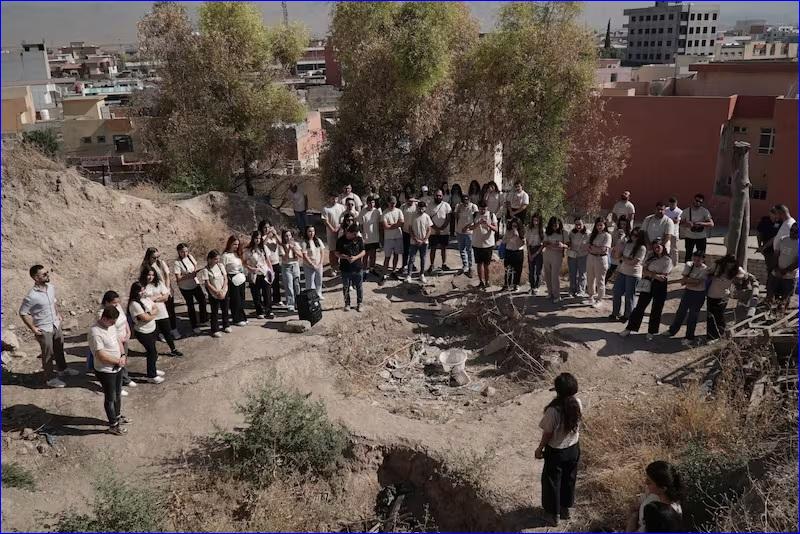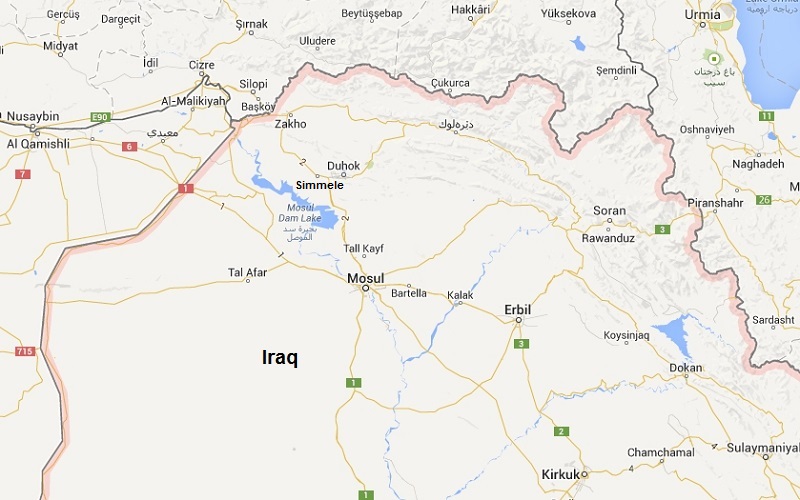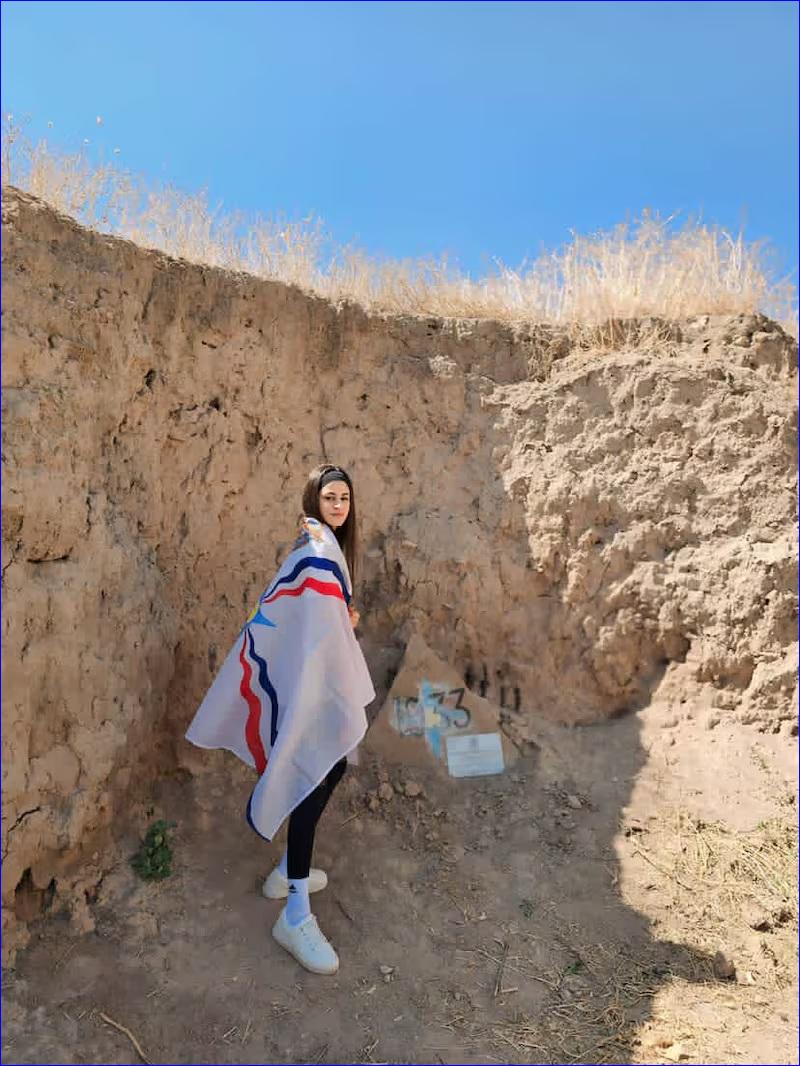


At the base of a mound of sand, a jagged slab of rock juts out of the ground, featuring the hand-painted date "1933" above the pale blue, four-pointed star of the modern Assyrian flag. Cracked plastic buckets, shreds of nylon grocery bags and snack wrappers litter the ground.
Related: The 1933 Massacre of Assyrians in Simmele, Iraq
"It was full of garbage, literal garbage," said Savina Dawood, founder of the Etuti Institute, a non-profit organisation focused on serving Assyrian young people in Iraq.
In 2024, the organisation hosted its annual youth leadership programme in nearby Bakhitme and organised a trip, and a volunteer clean-up, at the site. "We said some prayers and cleaned the entire site."
Underneath the litter-strewn earth are believed to lie human remains from the Simmele Massacre of 1933. Nearly a century later, the Assyrian community in Iraq and in the widespread diaspora mark August 7 as a day of commemoration of the victims of this and other events, now known as Assyrian Martyrs Day. For Assyrians, the state of the site is a sore reminder of the fate and status quo of the shrinking community.
Assyrians make up a distinct ethnic group native to parts of what is now Iran, Iraq, Turkey and Syria. Also called Chaldeans and Syriacs, the majority of Assyrians are Christians of different denominations.
Over decades of armed conflict in Iraq, as well as targeted persecution, the Assyrian community in Iraq has dwindled. It went from about 1.5 million before the US invasion of Iraq in 2003 to what community-compiled data from sources including churches and NGOs estimated to be about 150,000 in 2024.
The population thinned further after the ISIS takeover of parts of Iraq in 2014, which killed thousands of minorities including Assyrians and Yazidis.
" There are these moments of mass ... expulsion," Sargon Donabed, professor of history at Roger Williams University in Rhode Island, US, says. "But there's also a process where slowly, over time, as the community haemorrhages people one way or another, their actual reality diminishes."

Assyrian Affair
In what was then the newly established Kingdom of Iraq, Assyrian leaders, particularly the head of the Assyrian Church of the East, Shimun XXI Eshai, saw an opportunity to seek Assyrian autonomy within Iraq.
He and his allies led a public campaign, bringing a case to the League of Nations and petitioning the UK for support.
Mr Eshai was eventually exiled to Cyprus. And in response to that campaign, beginning on August 7, 1933, members of the Royal Iraqi army led a days-long assault on the Assyrian community of Simmele.
British accounts estimate 300 to 600 were killed, while the Assyrian community pegs the figure between 3,000 and 6,000 across 64 to 100 villages. The massacre also came to be known in some accounts as the "Assyrian Affair".
One key account of that week was by Lt Col RS Stafford, at the time British administrative inspector for Mosul, who witnessed many of the events of the massacre. He described Iraqi troops shooting at Assyrians seeking refuge in their homes, and the army burning corpses in the aftermath of the massacre.
Simmele lies in what is now the Duhok governorate under the jurisdiction of the Kurdistan Region of Iraq, where members of the community say the village is overlooked and the site neglected.
Today, the trip has become somewhat of a pilgrimage for Assyrians visiting Simmele, whether from neighbouring governorates or on tour groups from diaspora hubs in the US or Europe.

From Canada, Simmele-native Maryam Isho recounted the story of her family. "We lost half our tribe in the Simmele Massacre," she told The National. "My grandfather always used to tell us: 'I'm sure I have a brother who's still alive somewhere.'"
On a family trip to Syria in 2011, Ms Isho said, locals made them aware of a village where it appears members of her family's larger tribe, the Hakkari-native Liwan, had resettled.
The next day, Ms Isho and her family made the trip to the neighbouring village.
"A man named Issa came forward and said to my father: 'Before you speak, let me tell you my father's story, then we'll hear your father's,'" she recalled. "He began speaking with a voice full of pain and longing. He told us that his father would always say: 'I'm sure my brother is still alive somewhere, and one day I will see him again.' He described details that were identical to what we had heard from my grandfather."
It was a family reunion like no other, she said.
"For as long as we knew, the Isho clan was believed to have been wiped out, and we thought we were the only ones left," she said. "The village was full of our family members, people we had believed were lost forever."
No recognition
Neither the Iraqi government nor that of its semi-autonomous Kurdistan Region has recognised the Simmele Massacre. The site in Simmele, suspected to contain mass graves of victims, remains unprotected.
The site in Duhok falls under the Kurdistan Regional Government's jurisdiction. On August 7, President Nechirvan Barzani issued a statement on the occasion of Assyrian Martyrs Day, saying the region "advocate[s] for the protection and promotion of cultural diversity, coexistence, and mutual acceptance".
The National has reached out to the Iraqi Ministry of Foreign Affairs for comment but has not heard back.
From afar in the US diaspora, Assyrian community organisers led persistent efforts for recognition: NGOs drafted templates to flood the social media inboxes of elected officials and delegations met their representatives to carve out avenues for pressure on their Iraqi or KRI counterparts.
Nearly a century later, the event lingers in the collective Assyrian conscience. In a Kurdistan Region roiled by ethnic tensions and abandoned by political leadership unable to assemble the current session of government, this particular frustration is palpable.
Assyrian political parties have repeatedly submitted legislation to the governments of both Iraq and the Kurdistan Region calling for recognition of the massacre. None of these attempts succeeded.
Yacoob Yaqo, secretary general of the Assyrian Democratic Movement (ADM), also known as Zowaa, said that the failure of Iraq's political organisations to adopt recognition of the massacre "reflects an unequal view of the sacrifices and tragedies of non-Muslim minorities".
A 2023 letter from the ADM addressed to Iraqi President Abdul Latif Rashid and seen by The National calls on the President to "submit a draft law" to "recognise the Simmele Massacre as a genocide against the Assyrian people".
Meanwhile, in the diaspora around the world, recognition is a means to appeal to constituencies. At a peak of Assyrian grass roots organising and civic engagement in the US, several political figures -- from local to federal levels -- would engage the community with formal recognition of Assyrian Martyrs Day, commonly called Assyrian Remembrance Day in official communications.
US Representative from Illinois Jan Schakowsky, whose Congressional district covers one of the largest Assyrian community hubs in Chicago, has issued multiple statements recognising the massacre, most recently in 2020.
In Arizona, also home to a dense population of Assyrians, US Congresswoman Debbie Lesko introduced bipartisan legislation recognising the massacre to Congress, which was co-sponsored by representatives from across community hubs, although the bill never went to a vote.
Within Iraq, the leader of the Iran-aligned Babylon Movement, Rayan Al Kildani, has pledged on his campaign trails to petition for an amendment to the Iraqi constitution that would include mention of Assyrians and the Simmele Massacre.
He is US-sanctioned for alleged human rights abuses, and the Chaldean Church has publicly denounced Mr Al Kildani, who identifies as Chaldean Catholic. The Babylon Movement is the political wing of the Babylon Brigades, the 50th Brigade of the Iran-backed Popular Mobilisation Forces (PMF).
Voters, rival parties and many in the Assyrian community accuse the Babylon Movement of electoral manipulation to dominate the Christian quota seats in the Iraqi parliament. They were won in previous elections by his ties to Shiite militias, they say, instead of authentic Christian votes.
In 2020, a group of NGOs issued a joint statement calling for the protection of the site of the Simmele Massacre, citing "exposed skeletal remains consistent with their designation as possible mass grave sites" that "warrant investigation".
Prof Donabed says recognition is valuable. He says there is "denial of the very existence of even the name of Assyrians".
"This is a long-term trajectory of suffering, but also a long-term attempt at recognising the continued suffering and maltreatment of Assyrians in various places."
Rooted in education
Ishtar Gabriel Hanna was 21 before she had heard of the Simmele Massacre, despite living only about 100km away in the village of Karamlesh, in Iraq's Nineveh province. Her first encounter came when she was a participant in the Etuti youth programme Ms Dawood headed in 2024.
"I was standing over the remains of my Assyrian ancestors," Ms Hanna told The National. "Imagine an entire people, as soon as they demanded their rights, being killed, their bodies left trapped under the rubble without burial or a funeral ... Our people who lived without rights and died unjustly."
Following decades of Baathist policy under the rule of Saddam Hussein, Assyrians in Iraq began establishing schools of their own, supplementing standard curriculums with Assyrian language and history, often teaching all subjects in the Assyrian language.
"It's very sad to see that in Iraq, from north to south, we do not learn about the Assyrian people, our history, especially our modern history, our cultural struggles, the massacres and the genocides," Ms Dawood said.
Assyrians in Iraq hope that formal recognition of the massacre would entail the protection of its physical site. Programmes like the ones Ms Dawood hosts through the Etuti Institute carry out regular clean-ups of the site.
"Instead of garbage, we want them to find a moment of respect, a moment of silence, a moment of learning," Ms Dawood said.
For families like Ms Isho's, recognition also brings an element of closure. "Recognising the Simmele Massacre is not just a political act -- it is an acknowledgement of our humanity and our right to exist," she said. "We want the Iraqi government to acknowledge what happened, to honour the victims, and to protect what remains of our presence and identity in Iraq."

or register to post a comment.